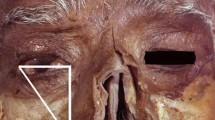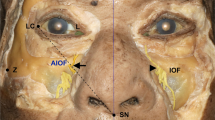Abstract
Background
Infraorbital nerve block can only be administered effectively with good knowledge of the location of the infraorbital foramen (IOF). In this article, we will describe the clinical landmark of the IOF with references to the infraorbital rim (IOR), mid-pupillary line (MPL), and facial midline (FML).
Methods
In our division, maxillary swing approach was adopted for the access of the nasopharynx and skull base. Through a Weber-Ferguson-Longmire incision, the maxilla was freed from its bony connections and swung out to expose the skull base. With this approach, the infraorbital foramen and nerve were identified under direct vision. Prospective measurements were taken intraoperatively on a series of patients who underwent maxillary swing operation. The distances between the IOF and various reference points (IOR, MPL, and FML) were measured with caliper. Means, standard deviations, and ranges were determined.
Results
From April 2009 to October 2012, 30 patients were included in this study. The locations of 30 infraorbital foramina were analyzed. The distances between IOF and IOR, MPL, and FML ranged from 8 to 12 (mean 9.6 ± 1.3) mm, 4 to 14 (mean 9.3 ± 2.4) mm, and 24 to 38 (mean 32.7 ± 3.4) mm, respectively.
Conclusions
To our knowledge, this is the first study in the literature demonstrating the clinical landmark of IOF on living persons and adopting MPL as a reference point. We believe that the IOR and MPL are convenient reference points for the accurate localization of IOF.
Level of Evidence: Level IV, diagnostic study.




Similar content being viewed by others
References
Canan S, Asim OM, Okan B, Ozek C, Alper M (1999) Anatomic variations of the infraorbital foramen. Ann Plast Surg 43:613–617
Aziz SR, Marchena JM, Puran A (2000) Anatomic characteristics of the infraorbital foramen: a cadaver study. J Oral Maxillofac Surg 58:992–996
Wilhelmi BJ, Mowlavi A, Neumeister MW, Blackwell SJ (2003) Facial fracture approaches with landmark ratios to predict the location of the infraorbital and supraorbital nerves: an anatomic study. Craniofac Surg 14:473–477
Song WC, Kim SH, Paik DJ, Han SH, Hu KS, Kim HJ, Koh KS (2007) Location of the infraorbital and mental foramen with reference to the soft-tissue landmarks. Plast Reconstr Surg 120:1343–1347
Gupta T (2008) Localization of important facial foramina encountered in maxillo-facial surgery. Clin Anat 21:633–640
Boopathi S, Chakravarthy Marx S, Dhalapathy SL, Anupa S (2010) Anthropometric analysis of the infraorbital foramen in a South Indian population. Singap Med J 51:730–735
Liu DN, Guo JL, Luo Q, Tian Y, Xia CL, Li YQ, Su L (2011) Location of supraorbital foramen/notch and infraorbital foramen with reference to soft- and hard-tissue landmarks. J Craniofac Surg 22:293–296
Chrcanovic BR, Abreu MH, Custódio AL (2011) A morphometric analysis of supraorbital and infraorbital foramina relative to surgical landmarks. Surg Radiol Anat 33:329–335
Zheng WX, Guo JL, Song BX, Liu XL, Lv DL, Tian Y, Li YQ, Cheng FB (2012) Location of the supraorbital and infraorbital foramen with references to the soft tissue landmarks in a Chinese population. J Craniofac Surg 23:1154–1155
Przygocka A, Podgórski M, Jędrzejewski K, Topol M, Polguj M (2012) The location of the infraorbital foramen in human skulls, to be used as new anthropometric landmarks as a useful method for maxillofacial surgery. Folia Morphol (Warsz) 71:198–204
Wei WI, Chan JY, Ng RW, Ho WK (2011) Surgical salvage of persistent or recurrent nasopharyngeal carcinoma with maxillary swing approach—critical appraisal after 2 decades. Head Neck 33:969–975
Wei WI, Ng RW (2008) Practical tips to perform a maxillary swing approach. In: Cernea CR (ed) Pearls and pitfalls in head and neck surgery, 1st edn. Karger, Basel, pp 102–103
Sinnatamby CS (1999) Last’s anatomy regional and applied, 10th edn. Churchill Livingstone, Edinburgh
Kleier DJ, Deeg DK, Averbach RE (1983) The extraoral approach to the infraorbital nerve block. J Am Dent Assoc 107:758–760
Dryden J (1993) An unusual complication resulting from a Gow-Gates mandibular block. Compendium 14:94–98
Saeedi OJ, Wang H, Blomquist PH (2011) Penetrating globe injury during infraorbital nerve block. Arch Otolaryngol Head Neck Surg 137:396–397
Hwang SH, Kim SW, Park CS, Kim SW, Cho JH, Kang JM (2013) Morphometric analysis of the infraorbital groove, canal, and foramen on three-dimensional reconstruction of computed tomography scans. Surg Radiol Anat 35:565–571
Conflict of Interest
None.
Ethical Standards
This research project was reviewed and approved by the ethical committee and have therefore been performed in accordance with the ethical standards laid down in the 1964 Declaration of Helsinki and its later amendments. All persons gave their informed consent prior to their inclusion in the study. Patients provided written consent for the use of their images. Details that might disclose the identity of the subjects under study were omitted.
Author information
Authors and Affiliations
Corresponding author
Rights and permissions
About this article
Cite this article
Liu, HL., Chan, YW., Ng, R.WM. et al. The clinical landmark of infraorbital foramen in Chinese population: a prospective measurement study. Eur J Plast Surg 37, 517–522 (2014). https://doi.org/10.1007/s00238-014-0977-x
Received:
Accepted:
Published:
Issue Date:
DOI: https://doi.org/10.1007/s00238-014-0977-x




